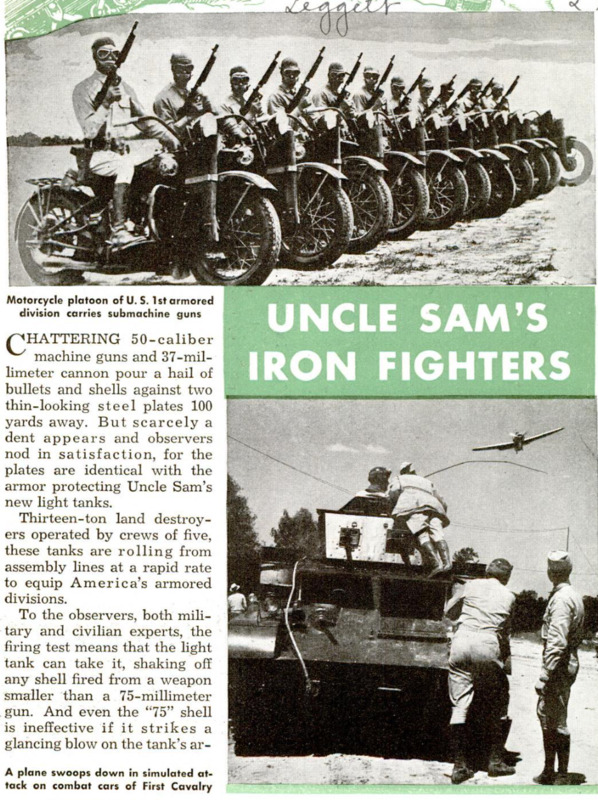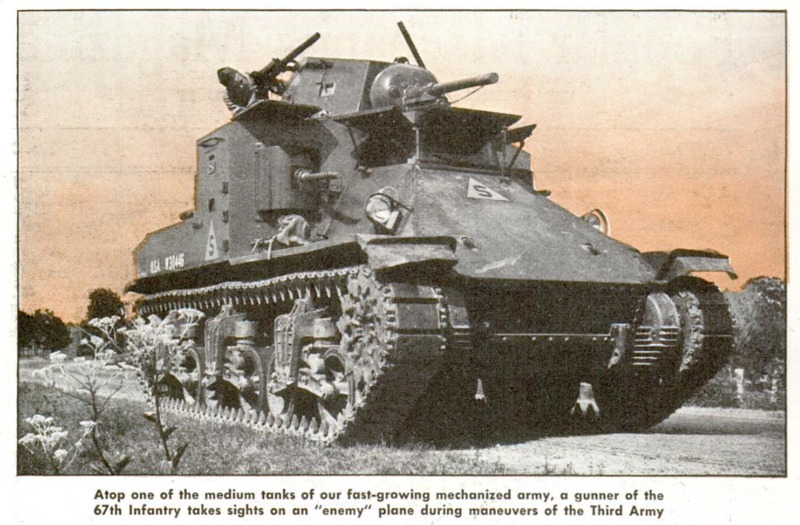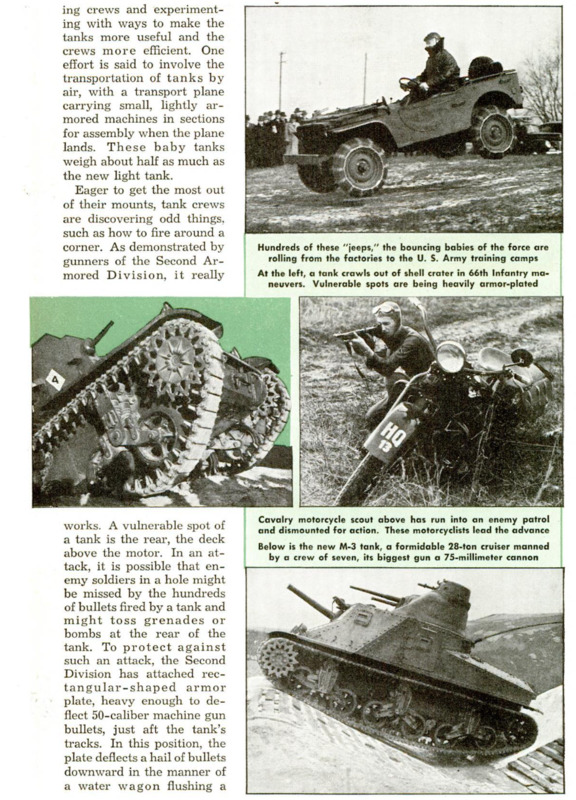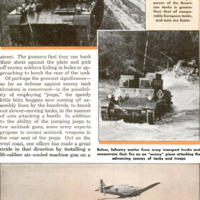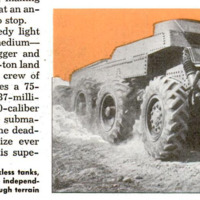CHATTERING 50-caliber machine guns and 37-millimeter cannon pour a hail of bullets and shells against two thin-looking steel plates 100 yards away. But scarcely a dent appears and observers nod in satisfaction, for the plates are identical with the armor protecting Uncle Sam’s new light tanks. Thirteen-ton land destroyers operated by crews of five, these tanks are rolling from assembly lines at a rapid rate to equip America's armored divisions. To the observers, both military and civilian experts, the firing test means that the light tank can take it, shaking off any shell fired from a weapon smaller than a 75-millimeter gun. And even the “75” shell is ineffective if it strikes a glancing blow on the tank’s armor - hardened steel plate along the flank and in front. Coupled with that fact is the difficulty of training the cumbersome “75” on the swift-moving, fast-turning tank. But a tough hide is not the only thing remarkable about these light tanks. They carry a real sting - a 37-millimeter, quick-firing cannon and four machine guns operated from the inside and an antiaircraft gun fired from the outside. Their gun power is greater than that of comparable tanks developed in Europe and their speed higher. Rated at only 35 miles per hour, they reach 50 easily, making they reach 50 easily, making them hard to hit, even at an angle, and even harder to stop. Backing up the speedy light tank is the slower medium - M-3 - but tougher, bigger and more formidable. A 28-ton land cruiser operated by a crew of seven, this tank carries a 75-millimeter cannon, a 37-millimeter cannon, four 30-caliber machine guns and one submachine gun, making it the deadliest machine of its size ever built. Its armor, too, is superior to that of comparable tanks in service across the Atlantic. Production of the M-3 is not as fast as that of the light tank, but factory wheels are turning at an ever accelerating pace, and it seems safe to predict that enough tanks of both types will be available within a short time. About 400 tanks - 290 light and 110 heavy - are needed to outfit an armored division, in addition to other types of vehicles used. As the iron fighting machines rumble off the line, U. S. Army officers are busy training crews and experimenting with ways to make the tanks more useful and the crews more efficient. One effort is said to involve the transportation of tanks by air, with a transport plane carrying small, lightly armored machines in sections for assembly when the plane lands. These baby tanks weigh about half as much as the new light tank. Eager to get the most out of their mounts, tank crews are discovering odd things, such as how to fire around a corner. As demonstrated by gunners of the Second Armored Division, it really works. A vulnerable spot of a tank is the rear, the deck above the motor. In an attack, it is possible that enemy soldiers in a hole might be missed by the hundreds of bullets fired by a tank and might toss grenades or bombs at the rear of the tank. To protect against such an attack, the Second Division has attached rectangular-shaped armor plate, heavy enough to deflect 50-caliber machine gun bullets, just aft the tank’s tracks. In this position, the plate deflects a hail of bullets downward in the manner of a water wagon flushing a street. The gunners find they can bank their shots against the plate and pick off enemy soldiers hiding in holes or approaching to bomb the rear of the tank. Of perhaps the greatest significance - so far as defense against enemy tank divisions is concerned - is the possibility of employing “jeeps,” the speedy little blitz buggies now coming off assembly lines by the hundreds, to knockout slower-moving tanks, in the manner of ants attacking a beetle. In addition to the ability of the jumping jeeps to tow antitank guns, some army experts propose to mount antitank weapons in the rear seat of the jeeps. Out on the west coast, one officer has made a great stride in that direction by installing a 30-caliber air-cooled machine gun on a tripod in the rear seat. With a speed of 60 miles an hour over rough country, jeeps armed in this manner would be able to swarm around a tank, dashing in at angles to attack the most vulnerable spots. In time, the jeeps probably will replace motorcycles as a means of reconnaissance and carrying messages. The fast, low-slung cars, driven by small but powerful engines, are getting their first big test in the 1941 war games. Experimental work is going forward on another fighting machine, a tank equipped with wheels instead of tracks. The wheels are so arranged that each acts independently while the tank is in motion, one dropping into a hole while others may remain on higher ground. An ingenious suspension tends to preserve equilibrium of men inside the machine, making for greater accuracy in firing, as well as greater comfort. Of importance are the tests being made on bulletproof tires. Such a development, reported to be near a state of perfection, would lend impetus to the tank-on-wheels. Scout cars, jeeps and other military vehicles also would be equipped with bullet-resistant rubber. Within less than a year, the U. S. Army expects to have six or eight armored divisions, each outfitted with 400 light and medium tanks and each containing 12,000 officers and men, At present each division also has about 300 scout cars, 400 motorcycles, 200 motor tricycles, 1,000 trucks, 500 machine guns, 25 37-millimeter antitank guns, 35 105-millimeter howitzers and 40 mortars. Changes are being made constantly and more may come as the year's maneuvers reveal points at which fire power may be increased. In contrast to the American armored division, the German “panzer” division contains about 14,000 officers and men and 3,000 tanks and other vehicles. The organization usually includes: one shock echelon consisting of 450 tanks; one ground-holding echelon consisting of a motorized infantry regiment of two battalions - each battalion having five companies armed with light and heavy machine guns, antitank guns and a regiment of 105-millimeter howitzers: one antitank battalion of three companies armed with 12 37-millimeter guns; a motorized engineer battalion, and one signal unit. The German division is more than 60 miles long when on the march. Brig. General G. M. Barnes of the Army Ordnance Department says that tanks being built for the U. S. Army are superior to any in the world and he credits the American steel industry with developing the toughest armor at the minimum weight. In addition, he points out that American tanks have a higher horsepower-to-weight ratio than those of any other nation - a feature of significance to engineers. It means simply that the American tank is faster and more maneuverable than other tanks because its engine has a lighter load. Among the problems encountered in tank design are those of compromises between desirable characteristics - armor with mobility, weight with speed, compactness with necessary facilities for crew and armament, steering with power tracks and others. But America’s engineers have overcome these problems and the armored divisions are on the move.

